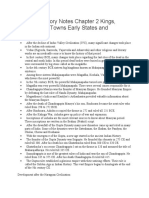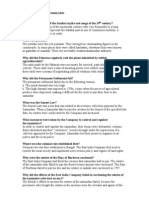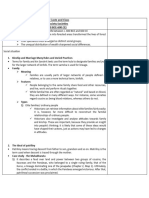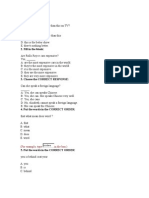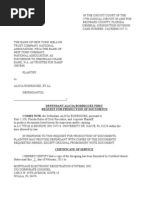CBSE Class 12 History Bricks Beads Bones Harappan Civilization
CBSE Class 12 History Bricks Beads Bones Harappan Civilization
Uploaded by
monika singhCopyright:
Available Formats
CBSE Class 12 History Bricks Beads Bones Harappan Civilization
CBSE Class 12 History Bricks Beads Bones Harappan Civilization
Uploaded by
monika singhOriginal Description:
Copyright
Available Formats
Share this document
Did you find this document useful?
Is this content inappropriate?
Copyright:
Available Formats
CBSE Class 12 History Bricks Beads Bones Harappan Civilization
CBSE Class 12 History Bricks Beads Bones Harappan Civilization
Uploaded by
monika singhCopyright:
Available Formats
Downloaded from www.studiestoday.
com
HISTORY
THEME-1
BRICKS, BEADS AND BONES
The Harappan Civilization
Key concepts in nutshells
Period:-
I. Early Harappan culture - Before 2600 BCE
II. Mature Harappan culture-2600BCE to 1900 BCE
III. Later Harappan culture-After 1900 BCE - 1500 AD
Extent of Harappan civilization:-
Northern boundary-Manda Southern Boundary-Daimabad
Eastern boundary-Alamgirpur Western boundary-Sutkagendor
Characteristics of the Harappan Civilization :-
(i) Planned Urban centre-unique feature of Mohan-jo-daro-Two Sections
a. The Citadel
b. The Lower Town
(ii) Laying out drainage
(iii) Domestics Architecture-
(a) warehouse / Granary
(b) Great Bath
(c) Brick used for construction of buildings
(d) Double story building
Other features
(i) Seals and Sealings used to facilitate long distance communication
(ii) Use of weights, usually made of stone called chart, generally cubical, with no marking.
(iii) Burials-to lay the dead in pits were found in Harappan Civilization some graves
contained pottery and ornaments indicating a belief that these could be used in after
life.
(iv) Use of enigmatic script-writing found in objects like seals, copper tools, rims of jars,
terracotta tablets, jewellery, bone rods.
- Some archaeologists are of the opinion that Harappan society had no rulers, whereas
other archaeologists feel that there was no single ruler but several rulers.
Downloaded from www.studiestoday.com
Downloaded from www.studiestoday.com
HISTORY
- Several explanation for the decline of Harappan civilization are Climatic changes,
deforestation, excessive floods, the shifting and / or drying up of rivers.
Metals Known :-
Gold, Silver, Copper, Bronze.
Scripts:-
The Harappan scripts are not yet undeciphered. There are 375-400 signs.
The script was written from right to left.
Craft:-
Chanhudaro was totally involved for craft production.
They were experts in bead makings, shell cutting, seal making,
Weight making. Lothal was also one of the important places for craft production.
Modes of Transportation:-
Bullock carts and Boats.
V. S. A (2 Marks)
Q.1 Our Knowledge about the Indus Valley Civilization is poorer than that of other civilizations,
why?
Ans:-Because -
- We are not capable to read the script of that age till now.
- Dependency on only archaeological sources .i.e. Buildings, seal, beads etc.
- For other civilization literary sources are available unlike Indus Valley Civilization.
Q.2 List the raw material required for craft production in Indus Valley Civilizations and how
these might have been obtained?
Ans:-
- Stone -like carnelian, jasper, crystal quartz, and steatite.
- Metal - like- copper, bronze, gold.
- Shell , faience and terracotta
Method of procuring material for craft production-
- A. They established settlement near the source of material -eg Nageshwar, Balakot
- B. They might have sent expeditions to areas such as the Khetri region of Rajasthan
(for copper) and south India (for gold)
Q.3 What was the confusion in the mind of Cunningham while studying Harappa Civilization?
Ans:-
Downloaded from www.studiestoday.com
Downloaded from www.studiestoday.com
HISTORY
- He used the accounts left by ChineseBuddhist pilgrims who had visited India between
the fourth and seventh century.
- He thought that Indian history began with the first cities in the Ganga Valley.
Q.4 What were the differences in techniques adopted by Marshall and wheeler in studying Indus
Valley civilization.
Ans:-
- Marshall tended to excavate along regular horizontal units, measured uniformly
throughout the mound ignoring the stratigraphy of the site. Due to this techniques
valuable information about the context of these finds was irretrievably lost.
- Wheelers recognized that it was necessary to follow the stratigraphy of the mound rather
than dig mechanically along uniform horizontal lines.
Q.5 What were the features of settlements of pre- Harappa period?
Ans:-
- They had no large buildings.
- There was a prevalence of agriculture and cattle rearing
- Some people were also engaged in sculpture.
- There was no well-planned network of roads and drainage system.
Q.6 How did the Harappans obtain red colour of carnelian?
Ans:-
- Harappans obtained red color of carnelian by firing the yellowish raw material and
beads at various stage of production.
Q.7 How do we know about the social difference among the Harappans?
Ans:-
- By study of the structure of burials and things found from these burials.
- By classifying artifacts into useful and luxurious things.
Q.8 How you can say that the people of Mohenjodaro were concerned about their privacy?
Ans:-
- On the basis of residential buildings & special structures.
- The main entrance of the houses was made in such a way that it did not give a direct
view of the interior or the courtyard.
- There were no windows in the walls along the ground level.
Q.9 Mention any four items found in the graves of the Harappans?
Ans:-
- Jewellary of both men and women ornaments consisting of three shell rings, a jasper
(Semi precious Stones) Beads and copper mirror.
Downloaded from www.studiestoday.com
Downloaded from www.studiestoday.com
HISTORY
Q.10 What were the animals of Harappans civilization?
Ans:-
- Pet animals :- Cattle , Sheep , Goat , Buffalo , Pig
- Wild animal: - Boar, Deer, Ghariyal.
Q.11 List the food items available to the people in Harappan civilization?
- Products taken from plants
- Fish and flesh
- Wheat, Millet, Pulses, rice etc.
Q.12 How you can say that there was a break between the early Harappan and the late
Harappan Civilization?
Ans:-
- There is evidence of large scale burning at some places or sites.
- The abandonment of certain settlements
S. A. (4 Marks)
Q.13 Why is Harappan script considered an enigmatic script or mysterious script?
OR
What are the main characteristics of Harappan Script?
Ans:-
- Because it is yet to be deciphered. Its mystery has still not been solved yet.
- It was not alphabetical. It had too many signs; all the signs symbolized certain things.
- The sign of this script were of the period 375 to 400.
- The script has been found on a variety of objects.
Q.14 Write a note on the agriculture technology of Harappans?
Ans:-
- The prevalence of agriculture is indicated by finds of grains in various sites of
civilization Archaeologist have found evidence of a ploughed field at seals and terracotta
sculpture indicates that the bull was known and oxen were used for ploughing.
- Two different crops were grown together.
- Canals and wells were constructed for irrigation. Traces of canals have been found in
all the Harappan site of Shortughai in Afghanistan, Water reservoirs have been found
in Dhaulavira.
Q.15 How can you say that the Harappan culture was an urban one?
Ans
- The cities was well planned into upper and lower town.
- The roads were straight and wide.
- The houses were made of burnt bricks and contained more than one storey. Every
house had a well and bathroom.
Downloaded from www.studiestoday.com
Downloaded from www.studiestoday.com
HISTORY
- The Drainage system was excellent with house drains emptying into street drains.
- Existence of public buildings.
- Lothal had a dockyard and was an important trading Centre.
Q.16 Write a note on the drainage system of Harappa?
Ans:-
- The drainage was made of mortar lime and gypsum.
- They were covered with big bricks and stones which could be lifted easily to clean
the drain .
- Smaller drains from houses on both the sides were laid on the main channel.
- Pits were provided for sewage for the houses.
Q.17 Discuss the functions that may have been performed by rulers in Harppan civilization?
Ans:-
- Some archaeologists say that Harappan society had no rulers and that everybody
enjoyed equal status.
- Others feel there were no single ruler but several.
- Under the guidance and supervision of the rulers, plans and layout of the city were
prepared.
- Big buildings, Palaces, Forts, Tanks, Wells, Canals, granaries etc were constructed
under the supervision of rulers.
- Roads, drains were also constructed and cleanliness was maintained under the
overall supervision of ruler.
- The ruler might have taken interest in promoting the farmer to increase production
and the craftsmen to promote different handicrafts
- He maintained and controlled extra ordinary uniformity of Harappa's artefacts like
- Seals, Weight and bricks.
- During foreign attack and natural disaster he used to play an active role by providing
security and food,
- He used to issue common acceptable coins or seals, weight and measurements.
Q 18- Write a short note on the seals of Indus valley people.
Ans:-
- More than 2000 seals have been found at the various sites.
- They are made up of various materials such as steatite, faience, ivory, pottery etc.
- They are very informative regarding dress, ornaments, hair styles etc.
- By the seals we know about the religions, commercial activities, etc.
Downloaded from www.studiestoday.com
Downloaded from www.studiestoday.com
HISTORY
Q.19- What do you know about trade and commerce of Indus valley civilization?
Ans:-
- Internal Trade: - was advanced Mohenjo-Daro, Harappa were main trade Centre. Heavy
and small weight has been found at these sites. These are made up in the multiple of
two as 1:2:4:8:16 upto 12,800.
- There was strict control on weight and measure.
- International trade - They had trade relation with other countries such as Egypt, Oman.
- The trade was carried both by sea and land
- Probably the metals like gold, silver, Tin and copper and precious stones were imported
from the other countries,
Q.20 - How did Harappan civilization come to an end?
Ans:-
- Some schools have tried to explain the important causes which led to the abandonment
of the mature Harappan sites by 1800 B.C. Some of them are as follows:-
- By Floods - It is speculated that a sudden flood might have submerged the various
town and buried them under the thick layer of mud.
- Due to the change in the course of Indus River.
- Climatic change - It is also possible that there was climate change and drought took
place due to deforestation.
- Earthquakes - It is also probable that the nature itself turned the whole land upside
down.
- Aryan Invasion - Some scholars say that Aryans were responsible.
Value Based Questions
Q 1:- What value do you attach to the work of Sir John Marshall in leaving India three
thousand years older than he had found her?
- He was the director general of Archaeological Survey of India
- By his effort it was proved that there existed a great civilization in India which
was contemporary of Mesopotamia.
- For this great - work we attach the value of thank fullness, indebtedness
Long Answer (8 Marks)
Q.21 How do archaeologist reconstruct the past?
Ans:-
- Recovering artefacts through excavation.
- Classification of finds that finds are whether tools or weapons or ornaments or
Downloaded from www.studiestoday.com
Downloaded from www.studiestoday.com
HISTORY
both or something meant for ritual use.
- An understanding of the function of an artifact is often shaped by it resemblance
with present day things. Beads, pots are obvious examples.
- Archaeologists reconstruct religious beliefs and practices by examining seals, some
of which seen to depict ritual scenes
- Archaeologists often move from known to unknown that is from present to past
regarding the reconstruction of religious practices.
- Remains of crops or pits are studied to identify food.
- By observing the different layers of sites they try to find out different things for
the information of Socio-economic conditions, religious and cultural life of past
people.
- Archaeologists also try to identify the function of an artefact by investigating the
context in which it was found.
- Use of indirect evidence eg. for clothing they depend on indirect evidence like
description in sculpture.
Source Based Questions
Read the given passage carefully and answer the Questionss that follow:-
"Evidence of an "invasion"
- Deadman Lane is a narrow alley, varying from 3 to 6 feet in width. At the point
where the lane turns westward, part of skull and the bones of the thorax and upper
arm of an adult were discovered, all in very friable condition, at a depth of 4ft
2in. The body lay on its backs diagonally across the lane. Fifteen inches to the
west were a few fragments of a tiny skull. It is to these remains that the lane owes
its name. FROM JOHN MARSHAL, Mohenjo-Daro and the Indus Civilization,
1931.
- Sixteen skeletons of people with the ornaments that they were wearing when they
died were found from the same part of Mohenjo-Daro in 1925.
- Much later, in 1947, R.E.M. Wheeler, then Director - General of the ASI, tried to
correlate this archeological evidence with that of the Rig-Veda, the earliest known
text in the subcontinent. He wrote:
- The Rig-Veda mentions pur, meaning rampart, fort or stronghold. Indra the Aryan
wargod is called purandara, the fort destroyer.
- Where are - or were - these citadels? It has in the past been supposed that they
were mythical ... The recent excavation of Harappa may be thought to have
changed the picture. Here we have a highly evolved civilization of essentially non-
Aryan type, now known to have employed massive fortification. What destroyed
this family settle civilization?
Downloaded from www.studiestoday.com
Downloaded from www.studiestoday.com
HISTORY
- Climatic, economics or political deterioration may have weakened it, but its
ultimate extinction is more likely to have been completed by deliberate and large
- scale destruction. It may be no mere chance that at a late period of Mohenjo-
Daro men, women, and children, appear to have been massacred there. On
circumstantial evidence, Indra stands accused.
FROM R.E.M. WHEELER, "Harappa 1946", Ancient India, 1947.
In the 1960s, the evidence of massacre in Mohenjo-Daro was Questionsed by an archeologist
named George Dales. He Demonstrated that the skeletons found at the site did not belong to
the same period: Whereas a couple of them definitely seem to indicate a slaughter, the bulk of
the bones were found in contexts suggesting burials of the sloppiest and most irreverent nature.
There is no destruction level covering the latest period of the city, no sign of extensive burning,
no bodies of warriors clad in armour and surrounded by the weapons of war. The citadel, the
only fortified part of the city, yielded no evidence of a final defense.
FROM G.F. DALES, "The Mythical Massacre Mohenjo-Daro", Expedition, 1964.
As you can see, a careful re-examination of the data can sometimes leads to a reversal of earlier
interpretation.
Q1. Name the archeologist who presented this source?
Ans: John Marshall
Q2. Which argument of the destruction of Harappa civilization, does this excerpt indicates?
Ans: - This except indicates that the Harappa civilization was destroyed by foreign invasion.
Q3:- Who corrected this evidence with RigVeda? Why?
Ans:- R.E.M.Wheeler. Rig-Veda mentions pur, meaning rampart, fort or strong-hold.
Indra, the Aryans' war-god is called purandara, the fort destroyer.
Q4:- Who propounded the theory opposite to this? How?
Ans :- George Dales. He hesitates to accept that this invasion was carried out by the Aryans.
He demonstrated that the skeletons found at the site did not belong to the same period:
Whereas a couple of them definitely seem to indicate a slaughter, the bulk of the bones
were found in contexts suggesting burials of the sloppiest and most irreverent nature.
There is no sign of extensive burning, no bodies of warriors clad in armour and
surrounded by the weapons of war.
QUESTIONS BANK:
VERY SHORT ANSWERS
- Q.01: What is the meaning of culture?
- Q.02: Who is the father of Indian Archeology?
- Q.03: What are the sources to know Indus Valley Civilization?
SHORT ANSWERS
- Q.01: Explain drainage system of this civilization.
- Q.02: What were the main Industries in Indus Valley Civilization?
Downloaded from www.studiestoday.com
Downloaded from www.studiestoday.com
HISTORY
LONG ANSWERS
- Q.1 Howdo archaeologist reconstruct the past?
MAP BASED QUESTIONS
- On the outline map of India Show the main archelogical sites of Harappan Culture :-
Downloaded from www.studiestoday.com
Downloaded from www.studiestoday.com
HISTORY
10
Downloaded from www.studiestoday.com
You might also like
- Manual of EFI System: Zhejiang Langjie Electronic Co., LTDDocument9 pagesManual of EFI System: Zhejiang Langjie Electronic Co., LTDwhyspeedfly100% (1)
- Geography Class 12 Notes Chapter 16 Water ResourcesDocument7 pagesGeography Class 12 Notes Chapter 16 Water Resourceshc17015650% (2)
- Spurious OVERWNG LOCK Inop Sys Displayed On Ecam: Engineering SupportDocument3 pagesSpurious OVERWNG LOCK Inop Sys Displayed On Ecam: Engineering Supportjontis jasoliya100% (2)
- Map ProjectionsDocument28 pagesMap Projectionsmonika singh100% (1)
- CH-1 Bricks, Beads and BonesDocument14 pagesCH-1 Bricks, Beads and BonesNandini SaxenaNo ratings yet
- Bricks, Beads and BonesDocument9 pagesBricks, Beads and BonesKaruna MauryaNo ratings yet
- Class Xii-history-Theme 1-Bricks, Beads and BonesDocument10 pagesClass Xii-history-Theme 1-Bricks, Beads and BonesNikhil Singh RajputNo ratings yet
- Class 12 History Notes Chapter 2Document5 pagesClass 12 History Notes Chapter 2Ahsas 6080No ratings yet
- Class 12th HistoryDocument47 pagesClass 12th HistoryahanaNo ratings yet
- Colonialism and The CountrysideDocument15 pagesColonialism and The CountrysideRamita Udayashankar83% (6)
- Class 12 History Notes Chapter 6 BhaktiDocument7 pagesClass 12 History Notes Chapter 6 BhaktiAhsas 60800% (1)
- CBSE Class 12 History Part-I: CHAPTER 2 KINGS, FARMERS AND TOWNS: Early States and Economics (C 600 BCE - 600 CE) Revision NotesDocument9 pagesCBSE Class 12 History Part-I: CHAPTER 2 KINGS, FARMERS AND TOWNS: Early States and Economics (C 600 BCE - 600 CE) Revision NotesAnshuman GuptaNo ratings yet
- Through The Eyes of TravellersDocument13 pagesThrough The Eyes of TravellersRamita Udayashankar100% (4)
- Class 12 Book 3 Ch-3 Graphical Presentation of DataDocument80 pagesClass 12 Book 3 Ch-3 Graphical Presentation of DataSooraj ChoukseyNo ratings yet
- Class 12 History Book 1 Short NotesDocument54 pagesClass 12 History Book 1 Short Noteslokanshu pandey50% (2)
- NS12 Ch5 .Through The Eyes of Travellers Perceptions of SocietyDocument6 pagesNS12 Ch5 .Through The Eyes of Travellers Perceptions of SocietyBADRI NARAYANA.KNo ratings yet
- Class 12 History Notes Chapter 1 BricksDocument6 pagesClass 12 History Notes Chapter 1 BricksAhsas 6080100% (1)
- CBSE Class 11 History WorksheetDocument1 pageCBSE Class 11 History Worksheetrishichauhan25No ratings yet
- Class 12th History - Kinship Caste and ClassDocument47 pagesClass 12th History - Kinship Caste and ClassRamita Udayashankar100% (1)
- Class Xii Geography Study Material 2023-24Document375 pagesClass Xii Geography Study Material 2023-24Mukul Maity100% (1)
- Themes in Indian History-Part-II - Class XIIDocument30 pagesThemes in Indian History-Part-II - Class XIIRohit Saxena100% (1)
- Class 12 History Notes Chapter 3 KinshipDocument5 pagesClass 12 History Notes Chapter 3 KinshipAhsas 6080No ratings yet
- Class 12 History NotesDocument126 pagesClass 12 History Noteshc170156No ratings yet
- MAHATMA GANDHI-The National Movement and The Quit India MovementDocument7 pagesMAHATMA GANDHI-The National Movement and The Quit India MovementOnline Subs100% (1)
- Question Bank in History Class XII PDFDocument62 pagesQuestion Bank in History Class XII PDFManthan KumarNo ratings yet
- Theme 5 - Through The Eyes of Travellers Perceptions of Society (C.Tenth To Seventeenth Century) (Lesson Notes) IntroductionDocument10 pagesTheme 5 - Through The Eyes of Travellers Perceptions of Society (C.Tenth To Seventeenth Century) (Lesson Notes) Introductionsayooj tvNo ratings yet
- CBSE Class 12 History Part-I: CHAPTER 4 THINKERS, BELIEFS AND BUILDINGS: Culture Developments (C 600 BCE - 600 CE) Revision NotesDocument9 pagesCBSE Class 12 History Part-I: CHAPTER 4 THINKERS, BELIEFS AND BUILDINGS: Culture Developments (C 600 BCE - 600 CE) Revision NotesAshish GangwalNo ratings yet
- An Empire Across Three ContinentsDocument5 pagesAn Empire Across Three ContinentsRamita Udayashankar67% (12)
- Theme 6 Bhakti-Sufi Traditions Lesson NotesDocument13 pagesTheme 6 Bhakti-Sufi Traditions Lesson NotesDPS MUN JODHPURNo ratings yet
- CBSE Class 12 Political Science WorksheetDocument1 pageCBSE Class 12 Political Science Worksheetmonika singh100% (1)
- 11 History Notes 05 Nomadic Empires PDFDocument5 pages11 History Notes 05 Nomadic Empires PDFAnjali RanaNo ratings yet
- Class9 IdpDocument3 pagesClass9 IdpVENKATA ABHINAV KOTTAPALLINo ratings yet
- CH 2 Kings Farmers and TownsDocument28 pagesCH 2 Kings Farmers and TownsSuman pariharNo ratings yet
- 10 Displacing Indigenous PeopleDocument13 pages10 Displacing Indigenous PeopleSarah SinghNo ratings yet
- Ch-3 Social Institutions Continuity and Change NotesDocument91 pagesCh-3 Social Institutions Continuity and Change NotesMalavika B100% (1)
- 12 History Key Notes CH 01 Bricks Beads and BonesDocument2 pages12 History Key Notes CH 01 Bricks Beads and BonesAbhinav Swaraj67% (6)
- CBSE Class 12 History Part-II: CHAPTER 4 Peasants, Zamindars and The State Agrarian Society and The Mughal Empire Revision NotesDocument9 pagesCBSE Class 12 History Part-II: CHAPTER 4 Peasants, Zamindars and The State Agrarian Society and The Mughal Empire Revision NotesAnshuman GuptaNo ratings yet
- History ProjectDocument13 pagesHistory ProjectRashi LalwaniNo ratings yet
- Land Resources and AgricultureDocument32 pagesLand Resources and AgricultureAdarsh TomarNo ratings yet
- History ProjectDocument29 pagesHistory Projectmaan.kulshrestha27No ratings yet
- Class XII History PPT of Video Lesson Theme 4 Thinkers, Beliefs,&..Document32 pagesClass XII History PPT of Video Lesson Theme 4 Thinkers, Beliefs,&..virenbasoya007No ratings yet
- XII History Theme 5 Through The Eyes of TravellersDocument8 pagesXII History Theme 5 Through The Eyes of TravellersJyotismita KhataniarNo ratings yet
- Class 12th Political Science (Contemprory World Politics)Document504 pagesClass 12th Political Science (Contemprory World Politics)sumanshek.0022No ratings yet
- 12 History Impq Map Work 01Document11 pages12 History Impq Map Work 01Anjli Sharma83% (6)
- History Women in Mughal PeiodDocument14 pagesHistory Women in Mughal Peiodyashvika100% (1)
- Kings Farmers and Towns Notes PDFDocument8 pagesKings Farmers and Towns Notes PDFPriya MeenaNo ratings yet
- 11 History Notes 11 Paths To Modernization PDFDocument7 pages11 History Notes 11 Paths To Modernization PDFbasudevNo ratings yet
- Chapter 7Document25 pagesChapter 7Harsh SharmaNo ratings yet
- Tarun Bharat SanghDocument9 pagesTarun Bharat SanghAdityaNo ratings yet
- 6 Bhakti Sufi Traditions: Main SourcesDocument30 pages6 Bhakti Sufi Traditions: Main Sourcesharsh kumarNo ratings yet
- Geography Class 12 Important Questions Chapter 4 Human DevelopmentDocument24 pagesGeography Class 12 Important Questions Chapter 4 Human DevelopmentSiddharth GhoshNo ratings yet
- NCERT Class 12 History Chapter 1 Notes Bricks Beads and Bones inDocument27 pagesNCERT Class 12 History Chapter 1 Notes Bricks Beads and Bones inNaman GargNo ratings yet
- Saransh Prasad, Indian Economy On The Eve of IndependenceDocument31 pagesSaransh Prasad, Indian Economy On The Eve of IndependenceKhalkho UmeshNo ratings yet
- CBSE Class 12 Political Science Sample Paper-02Document5 pagesCBSE Class 12 Political Science Sample Paper-02cbsesamplepaperNo ratings yet
- Worksheet Xii Geography 2023-24Document67 pagesWorksheet Xii Geography 2023-24Priya GogoiNo ratings yet
- 11 Paths To ModernisationDocument20 pages11 Paths To ModernisationGouri NandhanaNo ratings yet
- Class 12 History Cheatcode - HUMANATEASEDocument14 pagesClass 12 History Cheatcode - HUMANATEASEDarshna soniNo ratings yet
- Viii His L05 M01 When People Rebel PPTDocument17 pagesViii His L05 M01 When People Rebel PPTLakshay poswalNo ratings yet
- Revolt of 1857Document8 pagesRevolt of 1857siddharthNo ratings yet
- Theme 9 - Colonialism and The CountrysideDocument13 pagesTheme 9 - Colonialism and The CountrysideRudra YadavNo ratings yet
- Kinship, Caste and ClassDocument18 pagesKinship, Caste and ClassgajenderNo ratings yet
- Theme-1 Bricks, Beads and Bones The Harappan Civilization: Key Concepts in NutshellsDocument10 pagesTheme-1 Bricks, Beads and Bones The Harappan Civilization: Key Concepts in NutshellsSaptarshi BhattacharyaNo ratings yet
- Anthropology Paper IDocument2 pagesAnthropology Paper Imonika singhNo ratings yet
- Geography Mmp2024 Levelup King r Queen pDocument53 pagesGeography Mmp2024 Levelup King r Queen pmonika singhNo ratings yet
- Do Not Open This Test Booklet Until You Are Asked To Do So: Time Allowed: 2 HoursDocument14 pagesDo Not Open This Test Booklet Until You Are Asked To Do So: Time Allowed: 2 Hoursmonika singhNo ratings yet
- Emergency Chapter 20181019160648Document10 pagesEmergency Chapter 20181019160648monika singhNo ratings yet
- Class 12 Poi SciDocument11 pagesClass 12 Poi Scimonika singhNo ratings yet
- +3 Cbcs Syllabus: Pol. Sc. HonoursDocument105 pages+3 Cbcs Syllabus: Pol. Sc. Honoursmonika singhNo ratings yet
- 12 Geography 20Document9 pages12 Geography 20monika singhNo ratings yet
- Hsslive-2H (7) An Imperial Capital-Signed PDFDocument65 pagesHsslive-2H (7) An Imperial Capital-Signed PDFmonika singh100% (2)
- Question Bank - CommDocument2 pagesQuestion Bank - Commmonika singh100% (1)
- B1 12 Geography Key Notes CH 01 Human Geography Nature and ScopeDocument3 pagesB1 12 Geography Key Notes CH 01 Human Geography Nature and Scopemonika singh100% (1)
- 12 History 20 PDFDocument15 pages12 History 20 PDFmonika singhNo ratings yet
- Class XII Political Science 2008 Delhi and Outside Delhi PDFDocument26 pagesClass XII Political Science 2008 Delhi and Outside Delhi PDFmonika singhNo ratings yet
- Hsslive XII History Objective Ch8 PDFDocument3 pagesHsslive XII History Objective Ch8 PDFmonika singhNo ratings yet
- CBSE Class 12 Geography Concept of Human Development PDFDocument3 pagesCBSE Class 12 Geography Concept of Human Development PDFmonika singhNo ratings yet
- 11 English Core Usp 2016 2017 Set A Sa 1Document12 pages11 English Core Usp 2016 2017 Set A Sa 1monika singh100% (1)
- Hsslive XII History Objective Ch2Document2 pagesHsslive XII History Objective Ch2monika singhNo ratings yet
- CBSE Class 12 Political Science WorksheetDocument2 pagesCBSE Class 12 Political Science Worksheetmonika singh100% (1)
- CbseDocument43 pagesCbsemonika singhNo ratings yet
- Colonialism and The Countryside: Exploring Official ArchivesDocument47 pagesColonialism and The Countryside: Exploring Official Archivesmonika singh100% (3)
- B1 12 Geography Key Notes CH 03 Population CompositionDocument5 pagesB1 12 Geography Key Notes CH 03 Population Compositionmonika singhNo ratings yet
- Geography Class 11Document4 pagesGeography Class 11monika singhNo ratings yet
- Geography New PDFDocument202 pagesGeography New PDFmonika singhNo ratings yet
- Mahatma Gandhi and The Nationalist Movement: (Civil Disobedience and Beyond)Document4 pagesMahatma Gandhi and The Nationalist Movement: (Civil Disobedience and Beyond)monika singh100% (1)
- CBSE Class 12 Geography Geographical Perspective On Selected Issues and ProblemsDocument6 pagesCBSE Class 12 Geography Geographical Perspective On Selected Issues and Problemsmonika singh100% (2)
- Class XII Political Science 2008 Delhi and Outside Delhi PDFDocument26 pagesClass XII Political Science 2008 Delhi and Outside Delhi PDFmonika singhNo ratings yet
- Property Finals CasesDocument44 pagesProperty Finals CasesJudie Franz MarquezNo ratings yet
- Fedex AnalysisDocument92 pagesFedex AnalysisBill LeeNo ratings yet
- Inherited Overflow Metabolic Overflow RenalDocument11 pagesInherited Overflow Metabolic Overflow RenalChrissa Mae Tumaliuan CatindoyNo ratings yet
- CA Ramakrishna CVDocument2 pagesCA Ramakrishna CVCA Madhu Sudhan ReddyNo ratings yet
- Lesson Plan in Health IV JonaDocument8 pagesLesson Plan in Health IV JonaJenelyn Limen100% (1)
- Liu006 Dealing With MoneyDocument2 pagesLiu006 Dealing With MoneyGaik Heok TanNo ratings yet
- Ec Vvpat RtiDocument8 pagesEc Vvpat RtithequintNo ratings yet
- Exam 2Document6 pagesExam 2María Belkis Rozo MeloNo ratings yet
- Lord Kuthumi - Dolphins SpeakDocument8 pagesLord Kuthumi - Dolphins SpeakEmeraldRay0% (1)
- CF5396 - Sika LimitedDocument16 pagesCF5396 - Sika LimitedvjekosimNo ratings yet
- Votem Catalog Final (L) PDFDocument12 pagesVotem Catalog Final (L) PDFCarlos José DiazNo ratings yet
- Addwelltap: ParametersDocument5 pagesAddwelltap: ParameterssagarNo ratings yet
- Response To Court 1Document3 pagesResponse To Court 1Hilario RiveraNo ratings yet
- General Physics2 Lesson 4 PDFDocument2 pagesGeneral Physics2 Lesson 4 PDFJohn Renzo MolinarNo ratings yet
- Final ClinicalDocument8 pagesFinal ClinicalTop MusicNo ratings yet
- VOD ConferenceDocument15 pagesVOD ConferenceCARLOS OSIEL SEBASTIÁN VALDÉSNo ratings yet
- Diagnostic Accuracy of Xpert MTB/RIF On Bronchoscopy Specimens in Patients With Suspected Pulmonary TuberculosisDocument6 pagesDiagnostic Accuracy of Xpert MTB/RIF On Bronchoscopy Specimens in Patients With Suspected Pulmonary TuberculosisMARTIN FRANKLIN HUAYANCA HUANCAHUARENo ratings yet
- (Lonely Hearts Club 03.5) Be My Naughty Neighbor Bonus Epilogue - Liz FoxDocument2 pages(Lonely Hearts Club 03.5) Be My Naughty Neighbor Bonus Epilogue - Liz FoxSuelenMattos0% (1)
- Aakash AIPMT 2014 Solution Code Q PDFDocument27 pagesAakash AIPMT 2014 Solution Code Q PDFRohitDalal0% (1)
- Varsity Chronicles - by Leader TapfumaDocument33 pagesVarsity Chronicles - by Leader TapfumaLeader TapfumaNo ratings yet
- Partnership Agreement 2020 PDFDocument4 pagesPartnership Agreement 2020 PDFOlome EmenikeNo ratings yet
- FIVS Overview and Some Instructions: The Most Recent Events Concerning The FIVS Gen VDocument4 pagesFIVS Overview and Some Instructions: The Most Recent Events Concerning The FIVS Gen VDavid ReasterNo ratings yet
- Answer: Failures Resulting From Static Loading 241Document12 pagesAnswer: Failures Resulting From Static Loading 241Samawat AhsanNo ratings yet
- Artemis Brochure 2022Document7 pagesArtemis Brochure 2022StylianosNo ratings yet
- Diagnostic Exam For 7th GradeDocument11 pagesDiagnostic Exam For 7th GradeMariana Garza NaranjoNo ratings yet
- Primavera ManmionaDocument208 pagesPrimavera ManmionaNoman AwanNo ratings yet
- New Clients DataDocument118 pagesNew Clients Dataakash tiwari100% (2)
- Barangay Mataas Na Lupa Tanggapan NG Sangguniang Barangay: Republika NG Pilipinas Lalawigan NG Batangas Lungsod NG LipaDocument4 pagesBarangay Mataas Na Lupa Tanggapan NG Sangguniang Barangay: Republika NG Pilipinas Lalawigan NG Batangas Lungsod NG LipaCarl Mitchell GuevaraNo ratings yet








